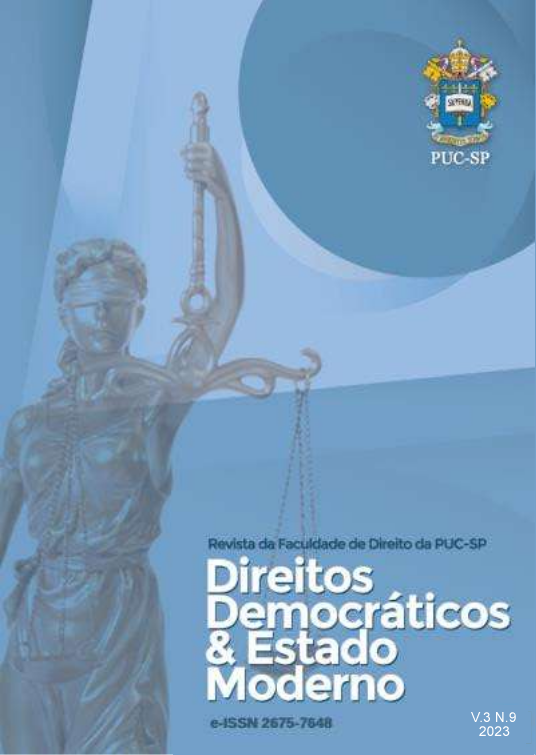A Persistência do tráfico internacional de mulheres
DOI:
https://doi.org/10.23925/ddem.v.3.n.9.60521Palavras-chave:
Tráfico de Mulheres, Tráfico Internacional, Crime, Exploração Sexual, Tutelas LegislativasResumo
O presente trabalho aborda a questão do Tráfico Internacional de Mulheres cujo crime é uma das maiores atividades lucrativas, hodiernamente. Dessa forma, esse crime tem como característica a forma em que os aliciadores escolhem suas vítimas, pois, de início, são enganadas com falsas promessas de um emprego bem remunerado e uma vida melhor em outro país, logo, os traficantes tiram seus passaportes, compram suas passagens aéreas e as transferem a outro local com o objetivo de exploração sexual. Em decorrência disso, assim que chegam ao país de destino descobrem que foram enganadas e são obrigadas a consumirem bebidas e drogas e, também, à prestação de serviços sexuais a fim de pagarem suas dívidas com os traficantes. Ademais, tem-se como objetivo analisar as características da mulher na sociedade e a divisão de gêneros em que o Brasil se encontra para, assim compreender, quais são os motivos históricos que acarretam até hoje para que a mulher sofra as sequelas desse crime. Assim, verificam-se as causas e consequências, bem como os perfis das vítimas e dos aliciadores, uma vez que, apesar de tamanho crime, o tráfico de mulheres ainda é uma temática que precisa de maior importância e com isso, busca-se compreender quais são as tutelas legislativas existentes para o tráfico, conforme seus tratados internacionais e quais as medidas que devem ser necessárias em nosso ordenamento jurídico brasileiro. Logo, pretende-se analisar por qual motivo as mulheres são as pessoas mais traficadas no mundo para o fim de exploração sexual e como combater o tráfico internacional de mulheres, com o escopo de identificar quais as ações do governo em prol ao combate ao Tráfico de Mulheres são efetivas. Assim, a metodologia adotada é a revisão de literatura, a pesquisa qualitativa e o método dedutivo.
Referências
ALMEIDA, Hugo Tiago. Tráfico Internacional de Mulheres: Conceituação, dados e legislação aplicável ao tema. 2011. Disponível em http://www.egov.ufsc.br/portal/conteudo/tr%C3%A1fico-internacional-de-mulheres-conceitua%C3%A7%C3%A3o-dados-e-legisla%C3%A7%C3%A3o-aplic%C3%A1vel-ao-tema. Acesso em 20 set. 2023.
ANTUNES, Ricardo. Os Sentidos do Trabalho: ensaio sobre a afirmação e a negação de trabalho. São Paulo: Boitempo, 2006.
AURELIANO, Muller. Uma análise do tráfico de pessoas à luz das convenções internacionais. 2016. Disponível em https://jus.com.br/artigos/50089/uma-analise-do-trafico-de-pessoas-a-luz-das-convencoes-internacionais. Acesso em 20 set. 2023.
BONJOVANI, Mariane Strake. Tráfico Internacional de Seres Humanos. São Paulo: Damásio de Jesus, 2003.
BRASIL. Decreto nº 5.017, de 12 de março de 2004. Promulga o Protocolo Adicional à Convenção das Nações Unidas contra o Crime Organizado Transnacional Relativo à Prevenção, Repressão e Punição do Tráfico de Pessoas, em Especial Mulheres e Crianças. 2004. Disponível em: http://www.planalto.gov.br/ccivil_03/_ato2004-2006/2004/decreto/d5017.htm. Acesso em 20 set. 2023.
BRASIL. Lei Nº 13.344, de 6 de outubro de 2016. Dispõe sobre prevenção e repressão ao tráfico interno e internacional de pessoas e sobre medidas de atenção às vítimas. 2016. Disponível em: https://www.planalto.gov.br/ccivil_03/_ato2015-2018/2016/lei/l13344.htm. Acesso em 16 mar 2023.
BRASIL. Secretaria de Políticas para as Mulheres. Plano Nacional de Políticas para as Mulheres: 2013- 2015. Brasília: Secretaria de Políticas para as Mulheres, 2013.
CASTILHO, Ela Wiecko V. de. Tráfico de pessoas: Da convenção de Genebra ao Protocolo de Palermo. 2014. Disponível em: <http://pfdc.pgr.mpf.gov.br/publicacoes/docs_artigos/artigo_trafico_depessoas.pdf>. Acesso em 20 set. 2023.
COMPARATO, Fábio Konder. A afirmação histórica dos direitos humanos. 9. ed. São Paulo: Saraiva, 2015.
COSTA, Rose. Brasil tem 241 rotas de tráfico de pessoas, diz ONU. 2012. Disponível em http://saopaulo.estadao.com.br/noticias/geral,brasil-tem-241-rotas-de-trafico-de-pessoas-diz-onu-imp-,956103. Acesso em 20 set. 2023.
DE SOUSA SANTOS, Boaventura; GOMES, Conceição; DUARTE, Madalena; BAGANHA, Maria Ioannis. Tráfico de mulheres em Portugal para fins de exploração sexual [Trafficking of women in Portugal for sexual exploitation]. Report. Coimbra: CES and CAIM. 2007.
HUMAN RIGHTS WATCH. Hopes betrayed: trafficking of women and girls to Post-conflict Bósnia and Herzegovina for forced prostitution. Vol. 14, Nº. 9. Trad. Boaventura de Souza Santos et al. (2007). 2002.
JESUS, Damásio Evangelista de. Direito penal: Parte especial. 18. ed. São Paulo: Saraiva, 2009. v. 3.
LEAL, Maria Lúcia; LEAL, Maria de Fátima (org.). Pesquisa sobre Tráfico de Mulheres, Crianças e Adolescentes para fins de exploração sexual comercial no Brasil. Relatório Nacional. Brasília: PESTRAF. 2002.
LEAL, Maria Lúcia; LEAL, Maria de Fátima. Pesquisa sobre o tráfico de mulheres, crianças e adolescentes para fins de exploração sexual comercial. Relatório Nacional. Brasília, 2003.
MACHADO, Maíra Rocha. O plano local e supraestatal de gestão de problemas e conflitos internacionais: o direito moderno em face da internacionalização do campo jurídico. 2003. 254 f. Tese (Doutorado em Filosofia e Teoria Geral do Direito) – Universidade de São Paulo, São Paulo, 2003.
ONU. Declaração Universal dos Direitos Humanos. 1948. Disponível em: http://www.onu-brasil.org.br/documentos_direitoshumanos.php. Acesso em 20 set. 2023.
ONU. Organização das Nações Unidas. Tráfico de seres humanos lucra US$ 30 mil por pessoa. 2017. Disponível em: http://www.onu-brasil.org.br/view_news.php?id=508. Acesso em 20 set. 2023.
PIOVESAN, Flávia. Direitos humanos e o direito constitucional internacional. 13ª ed. São Paulo: Saraiva, 2012.
SANTOS, Aida. The Philippines: migration and trafficking in women. In Raymond, Janice G. A Comparative Study of Women Trafficked in the Migration Process. Patters, profiles and health consequences of sexual exploitation in five countries (Indonésia, Philipines, Thailand, Venezuela and United States). CATW. Trad. Boaventura de Souza Santos et al. (2007). 2002.
SARLET, Ingo Wolfgang. Dignidade da pessoa humana e direitos fundamentais na Constituição Federal de 1988. 9. ed. rev. atual. 2. tir. Porto Alegre: Livraria do Advogado Editora, 2012.
SIFUENTES, Mônica. Críticas à Lei n. 13.344/2016–Tráfico de pessoas. Boletim Científico Escola Superior do Ministério Público da União, n. 54, p. 187-212, 2019.
SILVA BARBOSA, Cíntia Yara. Tráfico internacional de pessoas. Editora: Nuria Fabris. 2010.
SILVA, Ronaldo Alves Marinho; MATTOS, Fernanda Caroline Alves de. Tráfico de Pessoas: Uma análise da Lei Nº 13.344/2016 à luz dos Direitos Humanos. Revista Direitos Humanos e Democracia, v. 7, n. 14, p. 187-200, 2019.
SILVA, Waldimery Corrêa da. Tráfico de pessoas: necessidade de clareza conceitual entre o tráfico internacional de pessoas e contrabando de pessoas. In: PAGLIARINI, Alexandre Coutinho; RIBEIRO, Márcia Carla Pereira (org.). Sociedade e Direito. Rio de Janeiro: GZ Editora, 2013. p. 417-436.
TESCARI, Adriana Sader. Violência sexual contra a mulher em situação de conflito armado. Porto Alegre: Sérgio Antônio Fabris Editor, 2005.
Downloads
Publicado
Como Citar
Edição
Seção
Licença
Copyright (c) 2023 Direitos Democráticos & Estado Moderno

Este trabalho está licenciado sob uma licença Creative Commons Attribution 4.0 International License.

Este obra está licenciada com uma Licença Creative Commons Atribuição 4.0 Internacional.
Revista DD&EM - ISSN 2675-7648
















